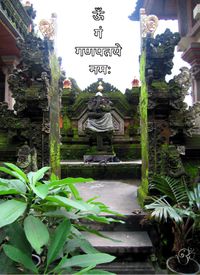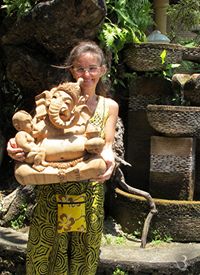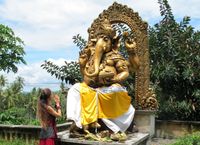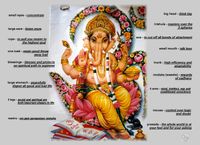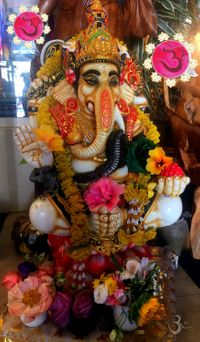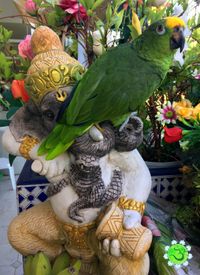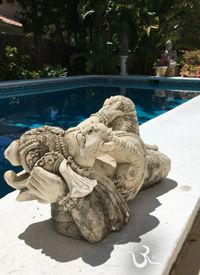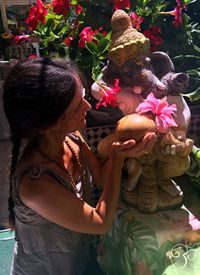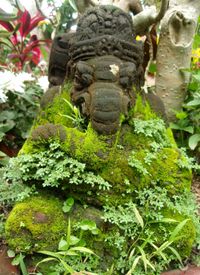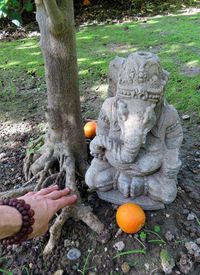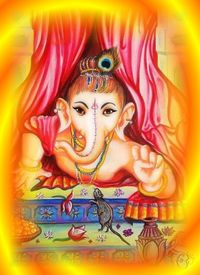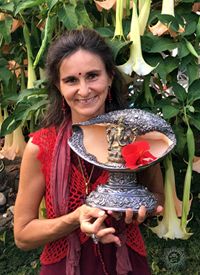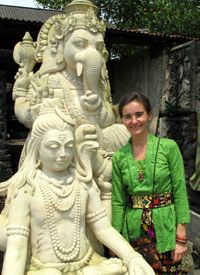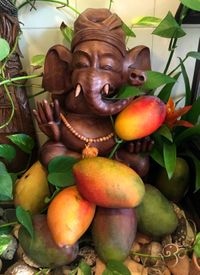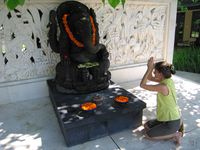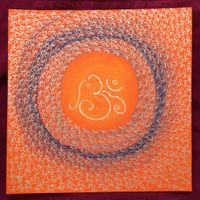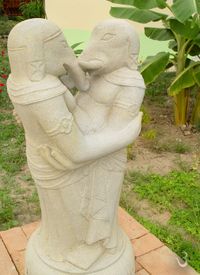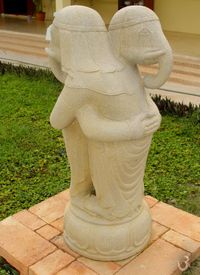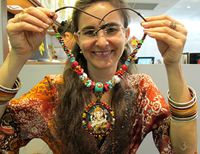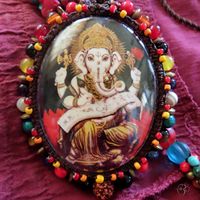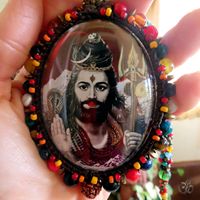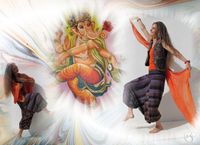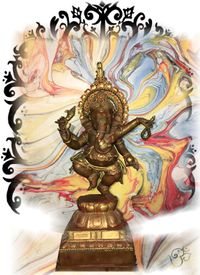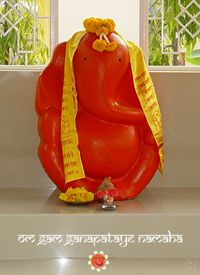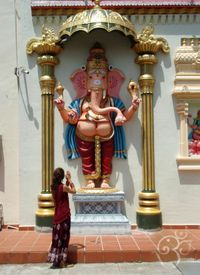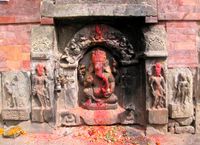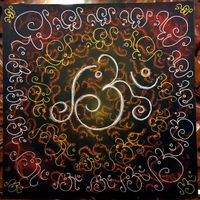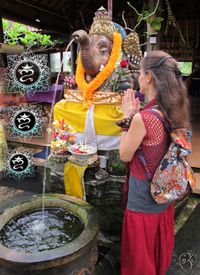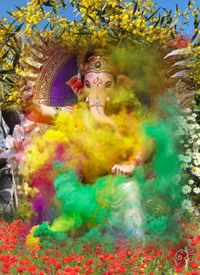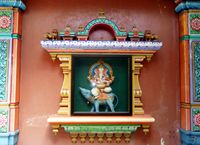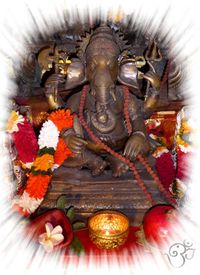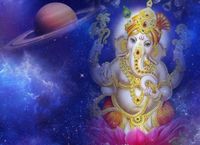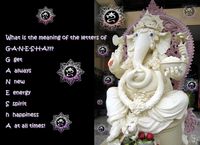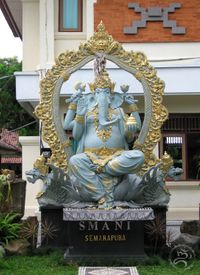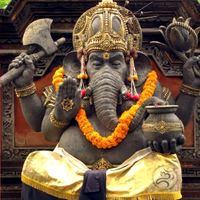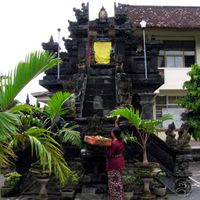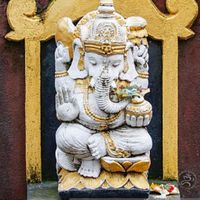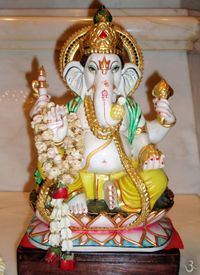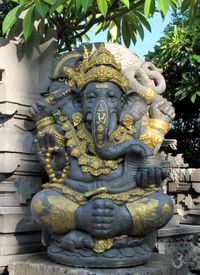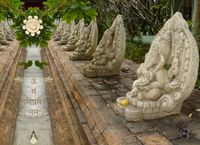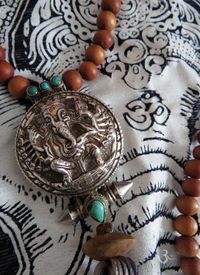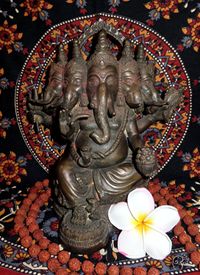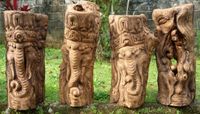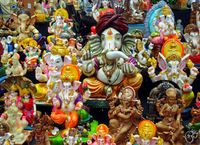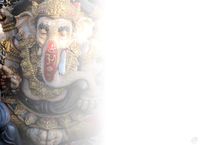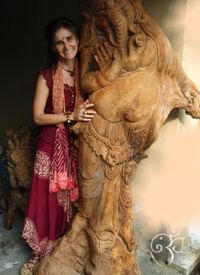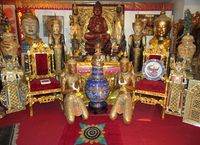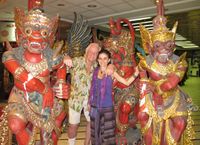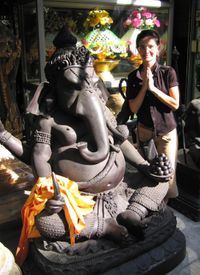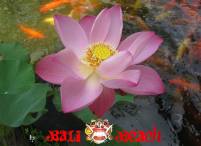ॐ एकदन्ताय विद्धमहे, वक्रतुण्डाय धीमहि, तन्नो दन्ति प्रचोदयात्॥
Om Ekadantaya Viddhamahe, Vakratundaya Dhimahi, Tanno Danti Prachodayat॥
You are currently on what is probably the most unusual page about Ganesha on the internet. A collection of many posts that I have published in the Global Gayatri Sangha. It is rather a flow through the world of the elephant-headed deity, a flow through the world of his meaning, his anectodes, his mantras, his fasting days and my personal experiences that I have had with him. But if you are looking for something specific about him, I have three more pages that will make it easier for you to find it. Here are the links:
If you want to get to know Ganesha, then click on the photo: “essence of Ganesha”
If you are looking for Ganesha mantras, then click on the photo “sacred mantras for Ganesha”
If you want to know something about the special fasting days of Ganesha,
click on the photo “Chaturthi Vrat - the fast days of Ganesha”
Or make yourself comfortable and immerse yourself in my flow through the world of Ganesha ...
When I started creating this website in 2019, I also planned a page with stories from the gods of Hinduism. But suddenly everything turned out differently. Mowgli, my little fur whirlwind came into my life. A gift of existence and I gave him all my time. Through him I experienced a new HERE and NOW! The website remained untouched for a long time - standstill.
2020 - who would have thought that our world could change so quickly? At the end of the year I went for a walk with Mowgli on the full moon night on the beach and asked myself: What remains of 2020? Perhaps you now think that I am listing the pandemic and all its negative economic and psychological consequences. No, at that moment I only remembered the beautiful experiences.
There were the wonderful weeks in Portugal, these rugged rocky coasts, the great wide ocean, the Atlantic, the endless, lonely beaches, an overjoyed Mowgli ... the cork oak forests, the impressive architecture and the loving, helpful, inspiring people.
There was this new experience of being at home for two months, yes, at hOMe, with myself. Time to fully blossom my yogic life. Spending time in the garden every day, observing everything carefully with awareness, becoming one with nature. Time to be, just BE.
There was this incredible silence. I only heard nature. I will never forget the day when there wasn't a single car on the expressway. Just the chirping of a cicada and the lovely song of a bird. So many small, inconspicuous things were important and gave me joy. It was a year of slowing down. Time? Unimportant. I'll be there when I arrive. A real arrival (at myself).
I've never seen so many sunsets on the beach before. Have I ever been on the beach as often before? There was never an evening where Mowgli and I didn't play in the sand. Those wonderful evenings in the warm, soft sand. The great sky, painted by Mother Nature, the sunlight on the waves of the sea. A gift of existence.
And then it was autumn, winter ... and I experienced the beach in a completely different way. The atmosphere at night was so magical. I only concentrated on the essentials. The stars and the moon shone above me. It was reflected on the sea, such a soft, meditative light. Yes light. For a long time I observed two stars without knowing that they were actually planets. Jupiter and Saturn. Every day they stood a little differently to each other and then the day came when they became one. The next day they looked like a comet. The star of Bethlehem? Wow, I got to experience something that can only be seen every 800 years! I was so grateful ...
I met so many lovely people. In everyday life, here on the Internet. So much compassion, so much affection, so much respect. There were so many gifts of humanity, kindness, attention.
2020 things have happened that I never expected. Would any of you have thought that people around the world would sing and meditate together on the internet every evening? The social media had become a true meeting place. Sure, it always has been, but 2020 something very special, different. I have become part of a very special sangha, a community full of compassion, love, confidence, appreciation and inspiration. A community that gives courage, that encourages people to go their own way. A community that listens, that has time for me, that understands me. A unity crowned by the OMline APPshram! From the bottom of my heart I thank Deva Premal, Miten and the Prabhu team for the Gayatri Sangha!
And it was the Gayatri Sangha who encouraged me to share my experiences with Ganesha. I've been writing about him every Monday (or at the beginning of the week) since the end of May 2020. Inspired by gatherings, conversations. I am thinking of my dear Sangha sister Judy right now. Another "sister" asked if I could recommend a Ganesha book. And Judy answered her before I did: “Nisarga is our Ganesha book!” And here, on this page, you will find my very unconventional “book”. An informational page about Ganesha certainly looks different in general. Ordered chronologically. His meaning, his birth, ... but why should I go the way of others? My posts were written so full of love, out of the here and now. And so they should be remembered...
ॐ OM GAM GANAPATAYE NAMAH SHARANAM GANESHA ॐ
I have learned through my own experience that everything in life has a reason, even if I don't understand it at first. Everything has a cause and to solve a problem I have to start at the root. I have to learn to understand the problem. As an Osho sannyasin "I don't believe", I "experience". And there is certainly no god with an elephant head in heaven. God has no particular form, there is only divine power, energy. And it is in everything that was, what is and what will be. I see the divine everywhere. And I thank the divine for everything. And often I also thank things that are more of an obstacle than they meet me with benevolence. I look at them from different perspectives. And that's where Ganesha comes into play. Incidentally, Osho had repeatedly emphasized that life is a drama, a theater play. We shouldn't take it too seriously. Ganesha statues (are everywhere with me, at home, at the shop, in my car, …) remind me all day that I have the strength to remove obstacles from the way. I am certainly not your typical, traditional Ganesha devotee. I also never ask for any wish to be granted. For me that is "begging". No, Ganesha just gives me the strength to believe in myself. He reminds me to use all of my own wisdom and knowledge. But there is of course a tightrope walk. When I write about Ganesha I often ask myself: should I also describe the traditional way of worshiping? And sometimes I think that's important. I love mantras and also use them very traditionally. They are integrated into my everyday life. There is a suitable mantra for every action. That makes me aware, aware of what I'm doing. It's also a kind of thanks. I don't know if you've read this before. Before I came to Osho, I belonged to the Hindu faith. Osho, of course, shattered everything I had believed in. But through him I got to know Hinduism from a different perspective. Sometimes that's how it should be. I have also lived in Bali for over 26 years and with the Balinese form of Hinduism. That is of course deep inside me. To understand a mantra, one should understand the background to it. If I want to recite a Ganesha mantra correctly, it is important that I know who Ganesha is. So not only that he is the elephant-headed god. How can a mantra work if I don't know what it means? The word-hole translation is usually irrelevant. Most of the time it just describes him. But what is behind this description? What does the tooth mean? What does the book mean? Do you understand what I mean? And with that in mind, you can become one with the mantra, one with Ganesha. You now know that you yourself have the power like Ganesha to solve problems. Incidentally, when it comes to mantras, I like the bijas, the seed sounds, most of all. You can omit all other words of the mantra, the bija is enough to connect with the power of the respective deity...
ॐOm Gam Ganapataye Namahaॐ
Om the sound of the universe ॐ
Gam the secret power sound of Ganesha It is his "seed syllable" or Bija mantra गं
Ganapataye another name of Ganesha, the remover of obstacles गणपतये
Ganesha is the formless energy from which everything manifests and into which everything will dissolve. Ganesh is the embodiment of spirituality, prosperity, wisdom and consciousness. Ganesha stands for the new beginning. This could be a business deal, a new job, a new relationship, a journey, a new building or apartment, etc.
Ganesha always reminds me, that I need not be afraid of obstacles. Remove them! And grow through experience! I only need courage and inner strength. Above all, obstacles only arise when I have expectations. If I look from a different perspective, they may disappear by themselves!
I start my morning by lighting a candle in front of Ganesha in my room (which I call "holy space") and singing the Ganesha mantra. A conscious new beginning! May I accept all obstacles as an opportunity for spiritual and creative growth. Thankful to BE in the here and now. Without expectation, but with a lot of energy! I do the same in our shop before we open it.
Even though I am no longer a Hindu (I am a Osho Sannyasin), Ganesha has remained in my life. Because he also tells me: I do not have to live ascetically to be religious. On the contrary, he affirms life, he says: Yes! The secular is just as important as the spiritual. It gives me a peaceful atmosphere and day.
ॐOm Gam Ganapataye Namahaॐ
Be aware, that Ganesha is in everybody of us, in every atom of the universe.
ॐOm Gam Ganapataye Namahaॐ
Be aware, that Ganesha is in everybody of us, in every atom of the universe.
Ganesha - the source of learning
Ganesha is the remover of obstacles, the patron of arts and sciences and the deity of intellect and wisdom. As the deity of beginnings, he is honoured at the start of rites and ceremonies. But did you know that Ganesha is also a source of learning? Every part of Ganesha's body teaches us something and has a deep spiritual meaning. And that's what I want to tell you about in this post. There are 32 forms and 108 names of Ganesha and each form has certain attributes. I chose one of the most common forms, the Vinayaka with the four arms, sweets, axe and rope. I took the photo in 1999 in Old Delhi. It was a little poster on an old house.
In the picture, Ganesha is sitting in an OM symbol. It's called “oṃkārasvarūpa”, the manifested form of the cosmic sound OM or AUM. Ganesha is identified with the mantra OM. OM refers to the notion that Ganesha personifies the primal sound. This is confirmed in the ancient writings of Ganapati Atharvahirsa. It says: “Oh Lord Ganapati, you are the Trimurti, the unity of Brahma, Vishnu and Maheshwara (Shiva). You are Agni, the fire. You are Surya and Chandra, sun and moon. You are Brahman. You are the three spheres of life (remember the Gayatri-Mantra: Bhur, Bhuvaha, Swaha!), Bhuloka, the earth, Bhuvarloka, the space, and Swargaloka, the heaven. You are the OM. Oh Lord Ganapati, you are all this!” Ganesha is the same energy which is the reason for this universe. It is the energy from which everything manifests and into which everything will dissolve. When Ganesha embodies all that is and we become one with him (for example singing the mantra), then we feel that we are also one with existence.
Ganesha's big head means "think big!"
No wonder Lord Ganesha is worshiped as the god of wisdom. Its elephant head indicates intelligence and discernment. The elephant is endowed with unusual characteristics, such as its fearless and majestic gait. It destroys every obstacle on its way. An elephant is also a symbol of self-confidence, perseverance, strength and courage. To symbolize these qualities of the divine, Ganesha is represented in the form of an elephant. And when we become one with Ganesha, we can absorb all of these qualities into our consciousness.
Ganesha’s small eyes symbolize concentration.
Ganesha’s eyes teach us to concentrate our mind. Mindfulness is the ability to be fully present, to be aware of where we are and what we are doing, and not to get so distracted by what is going on around us. You can practice mindfulness by sitting down, closing your eyes and watching your breath. Or you look into a light or a figure like Ganesha. You can also practice mindfulness in daily dealing with the things that you do. It's actually quite simple. Just concentrate on what you are doing and don't do something else at the same time. Mindfulness makes you sensitive. You will make up your own mind about what is right.
Ganesha’s Big Ears mean “listen more”.
Ganesha’s wide ears denote the ability to listen to people who seek his help. Ears are also used to gain knowledge. They signify the importance of listening in order to absorb ideas. But first listen! My beloved Guruji Osho always reminded us of the importance of listening. So to really listen, that is, just listen and not judge the other person's words straight away or misinterpret them with your own ideas. Then you hear everything that hovers like a fragrance between the words. With Osho it was the silence. True listening opens up other spheres.
Ganesha’s Trishul mark on his forehead
The Trishul is the weapon of Shiva, his father. The Trishul symbolizes life, which consists of three spheres: creation, maintenance, and destruction; past, present, and future; body, mind and atman; compassion, joy and love; spiritual, psychic and relative; clarity, knowledge and wisdom; heaven, mind and earth; and so on. The Trishula on Ganesha’s forehead symbolizes these spheres and Ganesha's mastery over it. So when we become one with Ganesha, then these three, I'll call them states of being, dissolve.
Ganesha’s Small Mouth means "talk less"
His mouth teaches us to believe in doing instead of talking. To value our words. To listen, think, do- and then talk. There are mutliple reasons for this. On the one hand, it is often better to take a deep breath before, for example, responding to rather negative conversations. If you look from a little distance, you may see that there is also a spark of truth in the other person's statement. On the other hand, speaking takes a lot of energy. Energy that you may urgently need for something else. I often find myself trying to speak. So no short conversation, but long conversations. And especially when I later realize that it has not led to anything. When you are on a spiritual path, silence is the greatest good. Use your energy to come to your center. And then something else. Have you not already noticed that the most important things in life do not need any language at all? You feel it!
Ganesha’s Single Tusk indicates Ganesha’s ability to overcome all forms of dualism.
We live in a world full of duality. But isn't it precisely this being torn between the worlds that divides us? This constant thinking between darkness and light? Duality creates problems. When I see, feel and live everything as a unit, then peace arises in me. One does not exist without the other. If I think carefully, there is really only that which is full of light. Darkness is just abstinence from light. Everything "negative" is just abstinence from the "positive". Can there be hatred when love is there? Is there an end? Is there a beginning? We tend to think that we end when our bodies end in the material world. This duality is created by the mind which creates the ego. Duality is the screen keeping us from realizing our real Self, which is beyond body and mind. Once we transcend this duality, we see the entire Universe as a single whole and we become aware of our true Selves. One of the key attributes of people who are Self-Realised is that they rise above their likes and dislikes and the pairs of opposites that world presents before them. Established in the permanent Divinity, they remain unperturbed by what the world has to offer; the joys and sorrows, the victories and losses. They understand the ways of the world. Giving their best at every juncture, yet understanding that, in the ultimate analysis, it is only a game. Relatively speaking, genuine seekers on the spiritual path also achieve this sense of peace to the extent that they have identified with the Self. This transcendence over the pairs of opposites (two tusks) in a person of perfection is indicated beautifully by Ganesha’s broken tusk.
Ganesha`s trunk
The trunk of Ganesha is a symbol of many things, and the side it is bent to is a symbol of what the image of Ganesha means, how it should be worshiped and what we can learn from it.
The elephant is the only creature that can perform all of its functions with its trunk. It smells, eats, drinks, bathes and works with its trunk. Ganesha's trunk is a symbol of the perfect balance between knowledge (Gyaan Shakti) and action (Karma Shakti). Ganesha uses his trunk to destroy obstacles and advance. It is also twisted and symbolizes the sound of OM, the universal sound. Have you ever seen the Tamil Omkara sign? It really looks like Ganesha's head. I put it on the picture as a kind of watermark. The trunk of Ganesha means flexibility and the ability to adapt and change over time. Perhaps you have already noticed that there are figures with the trunk turned to the left. But then there are also some with a straight trunk (rather rare) and then also those with the trunk to the right, as in my picture. I better do another post about the special meanings. Now I am explaining Ganesha based on this picture and thus the trunk to the right.
Ganesha with the trunk to the right appear almost exclusively in temples. These images are fervently and religiously venerated. The right side trunk is called "Siddhi Vinayaka". Ganesha is accompanied by two Shaktis, Siddhi and Buddhi. Siddhi lives on his right and therefore the idol with a trunk bent to the right is called Siddhi Vinayaka. The trunk on the right side symbolizes freedom from all worldly pleasures and the attainment of moksha. Therefore, such a figure is rather not for house altars, since people with families have duties and cannot let go of joys. Ganesha with the trunk to the right is connected to the energy of the sun. In yoga the pingali is called nade. You may have heard of this before when you were engaged in pranayama breathing. Just as the sun can both create and destroy, this Ganesha can lead you to happiness or put obstacles in your way because existence wants to help you get on the right path. So if you get involved in a Gansha with a trunk to the right, it would be good if you use the mantras correctly (i.e. pronunciation, rhythm and the right accompanying music) and familiarize yourself with the customs of worshiping Ganesha.
The four arms of Ganesha
Ganesha holds various objects in his four hands. These objects are all symbols of spiritual action and show us, how Ganesha can help us. They indicate how we can connect with the energy of Ganesha to remove obstacles (in all day live or on the spiritual path). But the arms themselves also have a meaning:
The four arms of Ganesha represent the four inner attributes of the subtle body. That is the mind (Manas), the intellect (Buddhi), the ego (Ahamkara) and the conditioned conscience (Chitta).
In the version of Ganesha that I chose for my explanation, my beloved deity has four hands.
In one hand he holds a rope, which represents Ganesha’s ability to help pull us up towards our ultimate goal of realization and liberation.
Another hand holds an axe to cut all attachments with the impermanent and material world we continually grasp for. The hand waving an axe is a symbol of the detachment of all desires, bearers of pain and suffering. The axe is intended to remind us that we have the opportunity to resolve problems and obstacles. In the end, they are just obstacles to our mind.
In his third hand, he holds a bowl full of laddus, sweets, which represents rewards for spiritual development. Ganesha is never shown eating the laddus. The wise man never partakes of the rewards of his deeds. He is not attached to them.
His fourth hand is shown in a mudra, with the most common depiction of him showing the blessing mudra, which looks almost identical to the “Abhaya” or “fearless” mudra. Ganesha offers protection and guidance to the spiritual seeker. We must also offer that same grace and blessings to those we meet on the path of life. This hand gesture is taken by many deities as a way of blessing those who worship them.
Ganesha’s “Cosmic” Big Belly
Ganesha’s belly contains infinite universes, the seven realms above and below and the seven oceans are inside Ganesha's cosmic belly. The big belly signifies also his over activated kundalini energy which he had stored in his navel.
The big cosmic belly signifies the ability of Ganesha to swallow the sorrows of the universe and protect the world. It is said that Lord Ganesha's belly is considered a symbol of happiness. His big belly means to understand the good and bad things, that is, digest them properly and then give your decision. So you will attain the virtue of calmness.
Ganesha’s legs
Perhaps you have already noticed that Ganesha only touches the earth with one foot. The other leg is either in the meditation pose above the knee or it is half in the air as in the dance position. In my selected picture you don't see it so clearly, but only the left foot touches the earth, the left foot is a little higher. There are also Ganesha representations where this is not the case, for example when he is standing, crawling on the floor as a child or sitting in a yoga asana. But there, too, his two legs represent the social world on the one hand and the spiritual world on the other.
Social and spiritual are both important phases in life. The position of his legs indicate a way of living. It’s important to live in the social as well as in the spiritual world. When Ganesha is shown sitting with one foot on the ground and the other resting on his knee or above the ground, it means: Be in the world but not of it!
Ganesha’s Vahana (animal vehicle) the rat/mouse
Ganesha is often shown seated in front of a tray of Prasad, a devotional offering of sweets, fruits, food,etc. In these images Ganesha’s Vahana, the rat, is shown sitting in front of him, perhaps a bit to one side, looking up at him. The rat is a symbol of our senses, which are never satisfied. They crave new experiences, new tastes. Left uncontrolled, they keep growing forever. But a wise person rides on his senses (you have probably seen a Ganesha representation before, in which he is sitting on his rat). He keeps the senses (rat) under control. In the representation on my picture it means:
The senses of the wise person are under his control and the rat dare not eat the “Prasad” without the permission of Ganesha.
Ganesha sitting on a lotus flower
In general, lotus flowers represent spiritual enlightenment, growth, purity, and birth. Also the cycle of life, death, and rebirth. The lotus symbolizes one’s ability to perform their duty without being influenced by any desire, pleasure, or gain.
I hope that with the description of Ganesha, you could convey something about how Ganesha can help us. Ganesha is a great guru to us. Every part of the body, every attribute that he holds in his hands that accompanies him has a meaning. And all of these meanings are meant to remind us how to manage our lives.
When we recite "Om Gam Ganapataye Namaha" before starting anything what we are saying is that "In what we are about to do, let wisdom be our guide". In a way, Ganesha is our most powerful god, and he is usually called before we start rituals for other deities, before we start anything.
ॐOm Gam Ganapataye Namahaॐ
Ganesha, the god of happiness, wealth, good luck, prosperity and success
ॐ श्री गणेशाय नम
वक्रतुण्ड महाकाय सूर्यकोटि समप्रभ
निर्विघ्नं कुरु मे देव सर्वकार्येषु सर्वदा
The Vakratunda Ganesha Mantra is one of the first mantras I recite every morning in our shop-museum. It is like a soul food for me. We have several Ganesha altars in the shop. The statue, especially at the entrance, always receives a particularly large number of flowers. It is also worshiped by our neighbors and people walking by.
Ganesha is cheerful, courageous, meditative, wise, and goes new ways. The Vakratunda mantra has the power of unity and as such, it removes all energetic blocks from my existence.
Many people see Ganesha as the god of happiness, wealth, good luck, prosperity and success. He cannot give you these. You are responsible for all. But you can use his core statements as inspiration for your life. Take the obstacles that stand in your way as a chance. Do not damn this circumstances, but use all your strength to overcome them. Learn from these experiences. Have the courage to do something new. Be happy, playful and yet responsible.
The Vakratunda Mantra is one of the most important Ganesha mantras and also one of the most common Ganapati Mantras. It is the mantra for wealth and wisdom, The Vakratunda is dedicated to Ganesha and his consorts Goddess Riddhi (Hindu Goddess of Prosperity) and Goddess Siddhi (Hindu Goddess of spiritual enlightenment).
Vakratunda Maha-Kaaya Surya-Kotti Samaprabha
Nirvighnam Kuru Me Deva Sarva-Kaaryeshu Sarvadaa
“Salutations to Shree Ganesha, who has a curved trunk, who has a large body and whose splendour is similar to million suns. Oh Deva, please make my undertakings free of obstacles, by extending your blessings in all my works, always.”
Vakra – means one that is not straight.
Vakratunda – means curved trunk.
Mahakaya – means large body
Suryakoti – means “Surya” or sun and koti means crore.
Samprabha – means “prabha – aura” , “sama- like”.
Suryakoti samprabha – means whose aura is like light of crores of sun put together.
Nirvgnam – obstacle free.
Kurume – give me.
Deva – means God.
Sarva – means all.
Karyeshu -work.
Sarvada -always.
If you look at the mantra, you will see that it describes Ganesha. And exactly in this description lies the meaning for you, because if you know what his trunk and the big belly are saying, then you really understand the mantra.
Ganesha's trunk is a symbol of the perfect balance between knowledge (Gyaan Shakti) and action (Karma Shakti). Ganesha uses his trunk to destroy obstacles and advance. It is also twisted and symbolizes the sound of OM, the universal sound. The trunk of Ganesha means flexibility and the ability to adapt and change over time. Ganesha's big belly contains the infinite universe. It means that he has the ability to swallow all worries and problems. In a figurative sense, it should be said that you too have the ability to digest everything good and bad in life. Don't worry too much, keep calm!
My Guruji Osho once said that a sannyasin must have full trust in his guru. The Guru cannot give me enlightenment, but when I become one with his stillness, his being, then I find the direction back to my inner light. When I have full confidence in the energy and aura of Ganesha, then I will become one with what he embodies. And so I receive the blessings, happiness, prosperity and wealth.
ॐOm Gam Ganapataye Namahaॐ
Be aware, that Ganesha is in everybody of us, in every atom of the universe.
"You don't have to live ascetic to be religious"
This is an important aspect of Ganesha and very often our parrot "Kuki" illustrates this in a beautiful way !!!
The Ganesha mantra is one of the first mantras I recite every morning. It is like a soul food for me. Ganesha statues are everywhere in our hOMe. In all materials, colors and shapes. Ganesha is cheerful, courageous, meditative, wise, and goes new ways.
ॐOM GAM GANAPATAYE NAMAHAॐ
has the power of unity and as such, it removes all energetic blocks from my existence.
Many people see Ganesha as the god of happiness. He cannot give you happiness. You are responsible for that. But you can use his core statements as inspiration for your life. Take the obstacles that stand in your way as a chance. Do not damn this circumstances, but use all your strength to overcome them. Learn from these experiences. Have the courage to do something new. Be happy, playful and yet responsible. Live religiously on the "marketplace", as my beloved Guruji Osho said.
ॐOm Gam Ganapataye Namahaॐ
Be aware, that Ganesha is in everybody of us, in every atom of the universe.
In harmony with the whole – in a relaxed mood - yes, that's exactly the way to remove obstacles!
Let’s be relaxed! Everything does not always have to be quick and immediate. Looks at obstacles from a different perspective - relaxed. Existence "manages" an entire universe, why shouldn't it take care of us? And if something does not go as we imagine it was, it was our "idea" that did not fit into the "universal concept"!
My beloved Osho once said: "But start relaxing. Start from the circumference – that's where we are, and we can start only from where we are. Relax the circumference of your being – relax your body, relax your behavior, relax your acts. Walk in a relaxed way, eat in a relaxed way, talk, listen in a relaxed way. Slow down every process. Don't be in a hurry and don't be in haste. Move as if all eternity is available to you – in fact, it is available to you. We are here from the beginning and we are going to be here to the very end, if there is a beginning and there is an end. In fact, there is no beginning and no end. We have always been here and we will be here always. Forms go on changing, but not the substance; garments go on changing, but not the soul…
Tension means hurry, fear, doubt. Tension means a constant effort to protect, to be secure, to be safe. Tension means preparing for the tomorrow now, or for the afterlife – afraid tomorrow you will not be able to face the reality, so be prepared. Tension means the past that you have not lived really but only somehow bypassed; it hangs, it is a hangover, it surrounds you…You will have to relax from the circumference. The first step in relaxing is the body. Remember as many times as possible to look in the body, whether you are carrying some tension in the body somewhere – at the neck, in the head, in the legs. Relax it consciously. Just go to that part of the body, and persuade that part, say to it lovingly "Relax!" …
And you will be surprised that if you approach any part of your body, it listens, it follows you – it is your body! With closed eyes, go inside the body from the toe to the head searching for any place where there is a tension. And then talk to that part as you talk to a friend; let there be a dialogue between you and your body. Tell it to relax, and tell it, "There is nothing to fear. Don't be afraid. I am here to take care – you can relax." Slowly slowly, you will learn the knack of it. Then the body becomes relaxed.
Then take another step, a little deeper; tell the mind to relax. And if the body listens, mind also listens, but you cannot start with the mind – you have to start from the beginning. You cannot start from the middle. Many people start with the mind and they fail; they fail because they start from a wrong place. Everything should be done in the right order…
If you become capable of relaxing the body voluntarily, then you will be able to help your mind relax voluntarily. Mind is a more complex phenomenon. Once you have become confident that the body listens to you, you will have a new trust in yourself. Now even the mind can listen to you. It will take a little longer with the mind, but it happens…
When the mind is relaxed, then start relaxing your heart, the world of your feelings, emotions – which is even more complex, more subtle. But now you will be moving with trust, with great trust in yourself. Now you will know it is possible. If it is possible with the body and possible with the mind, it is possible with the heart too. And then only, when you have gone through these three steps, can you take the fourth. Now you can go to the innermost core of your being, which is beyond body, mind, heart: the very center of your existence. And you will be able to relax it too.
And that relaxation certainly brings the greatest joy possible, the ultimate in ecstasy, acceptance. You will be full of bliss and rejoicing. Your life will have the quality of dance to it…
The whole of existence is dancing, except man. The whole of existence is in a very relaxed movement; movement there is, certainly, but it is utterly relaxed. Trees are growing and birds are chirping and rivers are flowing, stars are moving: everything is going in a very relaxed way. No hurry, no haste, no worry, and no waste. Except man. Man has fallen a victim of his mind...
Man can rise above gods and fall below animals. Man has a great spectrum. From the lowest to the highest, man is a ladder.”
(Osho, The Dhammapada: The Way of the Buddha)
In harmony with the whole –in a relaxed mood - yes, that's exactly the way to remove obstacles!
ॐOm Gam Ganapataye Namahaॐ
Be aware, that Ganesha is in everybody of us, in every atom of the universe.
Ganesha reminds me every day that I am part of this never-ending, divine dance of the universe.
Ganesha is the god of the beginning. He always reminds me that I don't just get started, but rather go inside myself at the beginning of every day, every trip or every project. Deep within me is the root that all I'm doing is good. Good in the sense that it's something that comes from my heart. Only what emerges from my deepest being can be wise and bring success or happiness. I never ask Ganesha for anything. So-called prayers are a kind of begging for me. As if existence doesn't give me what I really need. When I sit in front of Ganesha, chant the mantra or offer him my coconut, it is pure gratitude. Gratitude that I feel divinity every day. Gratitude that I am allowed to BE.
When I see Ganesha, I am happy. He always puts a smile on my face. And I know that I am not giving up, that I am needed, that I am part of the universe. I belong to the dance that moves and changes everything incessantly...
ॐOm Gam Ganapataye Namahaॐ
strong my wings
way beyond the sky
om gam ganapatayei namaha
strong my intention
strong my connection
across the universe
freedom freedom light
freedom freedom light
we are singing in celebration
om gam ganapatayei namaha
I can feel the wind in my wings!
Do not forget:
Obstacles are not bad!
See obstacles as a task that existence has given us. If we accept that and see them as a challenge, then we can be sure that we will learn a lot from them.
Obstacles make us grow, spiritually, but also in terms of real knowledge. We only learn through experience.
Obstacles also open us up to new ideas.
And sometimes we have to take detours to get there,
sometimes step by step.
The important thing is that there is no standstill
that we don't become a pond.
Let's stay in the river!
ॐOm Gam Ganapataye Namahaॐ
Be aware, that Ganesha is in everybody of us, in every atom of the universe.
How was Ganesha born?
There are different versions of the birth of Ganesha. The most common is the following story:
Once upon a time, Shiva went to meditate on the top of the mountain Kailash and left his wife Parvati at home alone. Parvati was then harassed by numerous admirers. After he didn't come back for years, the admirers said "He'll never come back". Then Parvati created Ganesha as pure being (Suddha) from the scrapped skin of her body at bath time and placed him in front of the entrance of her house. She instructed him not to let a man come near her and gave him supremacy over the heavenly hosts. Years later, Shiva remembered that he had completely forgotten his wife while meditating, and returned to his house. Ganesha stood there and denied him entry. Shiva did not accept that, a fight ensued and Shiva cut off Ganesha's head. Parvati was extremely angry about this: “You killed my son, go back to your mountain! I never want to see you again! ” Shiva was angry with himself. That was not how he had imagined his homecoming. He withdrew and looked for a solution. He then ordered his servants to bring him the head of the first creature they would find. However, this creature would have to face north. The servants made a thorough search and found only one elephant in that position. The elephant's head was cut off and taken to Shiva, who then placed it on Ganesha's body. Shiva made sure that from then on people invoke and worship Ganesha at the beginning of the day and all activities.
The Brahmanda Purana tells a different story about Ganesha's birth:
Once upon a time demons created obstacles and prevented souls trapped in worldliness from finding salvation. The goddess Devi (Parvati) saw this sad game and in her compassion she decided to put an end to this evil. Because the demons dared to put obstacles in the way of even the gods! At this point Devi looked into Shiva's face and smiled. From the “Shine” of her smile emerged a deity with an elephant face. Devi used this deity to stop the demons. Vighneshwara (name of Ganesha), the remover of obstacles, was born. He destroyed the blockages on the path of the gods.
Which one is true? My heart says: the second!
ॐOm Gam Ganapataye Namahaॐ
Be aware, that Ganesha is in everybody of us, in every atom of the universe.
Ganesha and the conch
Ganesha is known for the fact that you don't have to take everything so seriously to be religious. The following story teaches me that even a god like Vishnu does not hesitate to worship Ganesha. It also shows me that sometimes I should accept the external circumstances without complaining about them. There are situations that I can only change with humility.
Vishnu was known to have a conch with him that he kept with himself at all times. One day, he noticed that the conch was missing and it was nowhere to be found. This got him extremely annoyed and he rallied all his powers into finding the conch.
As the search for the conch was on, Vishnu suddenly began hearing the sound of the conch emanating from a distance. He began searching for it in that direction and soon realized that the sound was coming from Mount Kailash itself. As he reached the mountain, he found out that the conch had been taken by Ganesha and he was busy blowing it. Knowing that Ganesha will not relent easily, he sought out his father Shiva and asked him to request Ganesha to return the conch back to him.
Shiva said he, too, didn’t have any power of Ganesha’s wishes and the only way to appease him is to perform a puja for him. So, Vishnu did do that. He set up all the necessary elements for the puja and worshipped Ganesha with his heart. Seeing this, Ganesha was extremely pleased and he returned Vishnu’s conch back to him.
This is a wonderful story that showed how even a powerful god had to relent.
ॐOm Gam Ganapataye Namahaॐ
Do not forget the blessings of Ganesha before starting anything!
There are many stories about Shiva and Ganesha, but the following one goes beyond the relationship between father and son.
I have already told you about the story of Ganesha's birth. In it also occurred how Ganesha got his elephant head. Do you remember that?
Back then, Shiva fulfilled Parvati's wish that people have to invoke and worship their son Ganesha at the beginning of the day and during all activities.
However, Shiva forgot that the rule applied to him too.
Once Shiva went to war against the demons and took his entire army with him. But in the rush he forgot to worship Ganesha first. A deity is no different from a man in a hurry! And as so often, you have a problem afterwards, and that's exactly what happened to Shiva. On the way to the site of the battle, the wheel of his war chariot was damaged. He couldn't continue the journey. First Shiva thought of a bad omen from the gods. But then suddenly he remembered completely forgetting to worship Ganesha before going into battle.
Shiva stopped all his troops and immediately performed a full puja in honor of Ganesha. With Ganesha's blessing, Shiva went ahead and he and his army were able to defeat the demons.
This little story shows that you should always keep your word. Regardless of whether you are king or servant, rich or poor, teacher or student, a parent or the child: rules apply to everyone!
So don't forget every morning: give a small flower, light an incense stick or a candle. Chant the Ganesha mantra. Be one in heart with Ganesha. He is the formless energy from which everything manifests and into which everything will dissolve. Ganesh is the embodiment of spirituality, prosperity, wisdom and consciousness.
ॐOm Gam Ganapataye Namahaॐ
Ganesha and the golden mango
My day begins with the Ganesha mantra and on this photo you see the Ganesha, in front of which I sit every morning full of joyful love and recite the Ganesha-Mool-Mantra:
OM GAM GANAPATAYE NAMAHA
It is a statue depicting Ganesha as a child. He doesn't have many arms yet and his right tusk is still intact. This Ganesha sits in our bathroom. Every room is sacred to me. I have Ganesha statues in “important places” throughout the house. Everywhere they should remind me that there are obstacles to arouse creativity in me. Obstacles make me grow. The statues also remind me that I don't have to live ascetically to be spiritual. The worldly belongs to the whole just as much as the spiritual. The statues remind me to be mindful and conscious.
Yesterday I got the idea for this post spontaneously. Mango is being harvested on our coast and there are lots of mangoes to buy everywhere. The smell is incredible, heavenly, divine! And it occurred to me that there is a story of Ganesha and a mango. The statue actually has a book in its left hand. But it's loosely on it. A perfect hand for a sacred, golden mango!!!
Ganesha is called the god of knowledge and wisdom and there is a spectacular story that illustrates why it is so:
One day Shiva was relaxing in Mount Kailash with his wife Parvati and sons, Ganesh and Karthikeya. Yes, Ganesha had a younger brother called as Karthikeya. Both would get along well but, just like all other siblings, they would have moments of arguments and fights! Suddenly the sage (his name was Narada Muni) appeared before Shiva and prayed his obeisance to him. Now this sage was known to cause mischief wherever he goes and it looked like this was also going to be one of these times. Narada had a golden mango in his hands which he gave to Shiva.
Shiva was surprised and asked Narada, why had he come all the way to Kailash to bring him a very simple mango? Narada replied, that it not a usual mango, but the golden mango of knowledge. Whoever eats this mango will be granted eternal knowledge and wisdom. Shiva gratefully accepted the mango and wanted to cut it into four pieces. Everyone in the family should get something from it. But suddenly he stopped. Narada would never give anything if it wasn't tied to something. A rule, a condition or even a mischief or a disaster. So he asked Narada what conditions would be attached to it. The fruit could not be divided but only eaten by one person. While Narada was explaining to Shiva about the fruit, Parvati, Ganesh and Kartikheya appeared there. When the boys saw the golden mango, each wanted to eat it. Every boy now wanted to prove that he was the superior and therefore was allowed to eat the fruit. Shiva was frustrated as he did not want to be partial to one son over the other and neither did Parvati. So they decided to repay Narada with a tactic of their own. So Shiva assigned the decision to Narada. After all, he was responsible for bringing him into this situation. Trying to make the best of his situation, Narada came up with an idea:
The one who circles the world three times first is the winner and gets the golden mango!
Before Narada uttered these words, Kartikheya jumped into his vehicle, a peacock, and was soon out of sight. He really wanted to be the fastest. Ganesha remained with a thoughtful expression. Parvati looked worriedly at her older son and asked him if he wouldn’t like to go around the world. Ganesha thought about it.
Ganesha was still thinking when his brother flew by. He had already circumnavigated the world for the first time. Karthikeya told Ganesha to finally start because he didn't want to win that way. From the beginning he was sure that he would win this competition, because he had a peacock as his mount, his brother only a mouse. But Ganesha remained seated on the Kailash. When he finally got up, his brother flew by for the second time. Ganesha stayed calm because he knew that he would still win. Slowly he made his way to his parents and bowed deeply to them. Then he started circling his parents three times. Shiva and Parvati were at a loss and asked Ganesh why he was circling them and not the world as the task was.
Ganesha's answer made a deep impression on his parents because he said:
"My parents are my universe and my whole world! So if I circle you, it means that I have circled the whole world!"
He had just circled Shiva and Parvati for the third time when Karthikeya came back to the Kailash. He too had circled the world three times. Karthikeya was very happy, he was sure to have won, because to him it looked like Ganesha was still in the same place. But Ganesha had gotten ahead of him in his own way. In a loving voice, Shiva said to his younger son that Ganesha is the winner. That was incomprehensible to Karthikeya. How could Ganesh be the winner when he'd just stayed there. Then Shiva explained to him what his brother did and handed over the fruit to Ganesha. Karthikeya was upset that his brother had pulled a fast one over him, but he could do nothing as what Ganesh did was absolutely right and had proved to be much more intelligent than him.
What can I learn from this story?
Certainly wisdom and intelligence always come out on top in the end. But I also learn from it that I shouldn't always start running. In a figurative sense, this also means that I shouldn't always react the same way. First take a deep breath. After that everything looks different and I act with awareness.
consciousness, wisdom, creativity and eternal knowledge
ॐOm Gam Ganapataye Namahaॐ
Be aware, that Ganesha is in everybody of us, in every atom of the universe.
Ganesha always reminds me that I don't have to be afraid of even mental obstacles.
I just need courage and inner strength to remove them.
Out of this experience, something new always arises in me, I learn from it.
Obstacles are nothing evil, nothing bad.
They are part of life.
Life is not only made of light, but also of dark moments.
Where there is white, there is also black.
Harmony consists of the balance of opposites.
ॐOm Gam Ganapataye Namahaॐ
Ganesha as pure energy of OM
Before I sing with Deva Premal and Miten their modern version of the Ganesha Mool Mantra, I always wonder where my roots are. In terms of mantras, it is the sound of the universe, the OM.
“strong my roots
deep into the ground
strong my wings
way beyond the sky
strong my intention
i come in peace upon this earth
strong my connection
across the universe
freedom freedom light
I am dancing with creation
freedom freedom light
we are singing in celebration
om gam ganapatayei namaha
i can feel the wind in my wings!”
(Miten with Deva Premal)
My roots are in OM and lead me through OM to OM! For me everything came from OM,
the cosmic YES. Om is the primordial mantra, it is already described in the Upanishads.
When I recite/sing OM, my whole body vibrates.
When I repeat OM, I activate my chakras, my energy centers.
When I repeat OM, my mind opens. I love OM.
OM actually has four different parts.
It consists of A-U-M and the silence afterwards.
I am really rooted in OM.
I fly to another level of being with OM.
In OM I find my freedom.
And do you know that? My beloved deity Ganesha lives in OM. He is OM, without beginning, without end.
The written OM reminds not only me of Ganesh!
The Ganapati Atharvashirsa attests to this association. There it says (freely translated):
Oh Lord Ganesha, you are the union of the three cosmic functions of creation, maintenance and dissolution, Brahma, Vishnu and Shiva. You're the Vedic primal deity Indra. You are Agni, the fire, and Vayu, the air. You are Surya, the sun, and Chandrama, the moon. You are brahman. You embody the three worlds, Bhuloka (earth), Antarikshaloka (space) and Swargaloka (heaven). You are OM. You are everything that was, what is, what will be.
My little Likhita-Japa-Mandala embodies Ganesha as pure energy of OM.
ॐOm Gam Ganapataye Namahaॐ
Be aware, that Ganesha is in everybody of us, in every atom of the universe.
The Ganesha mantra has the power of unity
There are so many troubles in this world. Disagreements that unfortunately end in protests and violence. We have to understand each other, listen to each other. Real listening without having an opinion in our mind. True listening would change our world. Isn't it the case that misunderstandings lead to wars?
The Ganesha mantra has the power of unity and as such, it removes all energetic blocks from our mind. Continuous recitation creates healing vibrations. Have you ever seen how water molecules change depending on what music they are exposed to?
ॐOm Gam Ganapataye Namahaॐ
Many people see Ganesha as the god of happiness. An image of Ganesha cannot give you true happiness. Maybe for a moment. You are responsible for that. But you can use his core statements as inspiration for your life. Take the obstacles that stand in your way as a chance. Do not damn this circumstances, but use all your strength to overcome them. Learn from these experiences. Have the courage to do something new. Have the courage to approach other people or living beings. Just hug them. Laugh together. Be happy, playful and yet responsible. Be full of compassion, willing to compromise. Look from a different perspective. We are all part of the divine. All of our external as well as internal differences are parts of the whole. Let's hug, let's look at each other, like these Ganesha statues from the Ganesha Museum in Thailand!
ॐOm Gam Ganapataye Namahaॐ
Be aware, that Ganesha is in everybody of us, in every atom of the universe.
Ganesha mudra for the heart chakra
This is one of my Ganesha pendants. Incidentally, I wore it at the concert of Deva Premal, Miten and Manose in Malaga-Spain 2012. Manose (Newa) loved it and I also showed him the back. There is Shiva, the father of Ganesha. Ganesha for the "worldly", Shiva for the "inner, ascetic" in me. I bought this pendant in Little India/Bangkok in 2011. And when I held it up for the photo, the chain formed this heart! What a coincidence! Well, I want to take this as an opportunity to introduce you to a meditation method: Ganesha mudra for the heart chakra! The Ganesha Mudra helps to have more courage, more assertiveness and also to start something new.
Hold your left hand palm out in front of your heart. Now grasp the fingers of the left hand with the right hand with the palm facing the body. In principle you hook both hands with your fingers. Exhale and pull your hands apart without releasing the grip. Release the tension and inhale. Repeat 10 times for a total of 11 rounds (for all directions, center, up and down)
Recite the mantra for Ganesha three times, for the three worlds
(bhur-bhuvah-swaha/ Bhur: the Earth/the physical body/physical realm; Bhuvah: the space/the life force/the mental realm Swaha: the heaven/the soul/spiritual realm)
Om Gam Ganapataye Namaha – Om Gam Ganapataye Namaha – Om Gam Ganapataye Namaha
Change hand positions with the right palm facing outward and left palm facing inward.
Repeat the exhalation and inhalation 10times
and intone the mantra for Ganesha three more times.
Om Gam Ganapataye Namaha – Om Gam Ganapataye Namaha – Om Gam Ganapataye Namaha
Focus on the heart center in silence for a while.
The Ganesha Mudra not only strengthens your courage, but also your health! This mudra strengthens the heart muscles and stimulates heart activity in general, releasing tension in the area. It opens up the heart chakra and stimulates courage, confidence and openness in relationships.
Do not forget: You have all the strength to overcome everything that stands in your way, everything that wants to test you!
ॐOm Gam Ganapataye Namahaॐ
Nritya Ganapati - the dancing Ganesha
“Paashamkushaa Poopakutaar Dhanta-
Chanchath Karamkluptha Varaanguleeyakam
Peethaprabham Kukshihikarastha Dhantam
Bhajaaminruththop Padham Ganesham”
Oh divine!!! You are probably thinking now. In fact, of course, it is not quite as easy to learn as the simple Bija mantra “om gam ganapataye namaha”. Below you will find out what it means.
In the beginning of 2021 one of my dear Ashram sisters mentioned in a reply that she had never seen a dancing Ganesha. And it struck me that I had never spoken about this form, the 15th form of Ganesha, even though I give a “Namaste greeting” to so many every day. The dancing Ganesha is actually a very common form. A few days later we met with Manose (Neva) at the OMline Ashram. Our beloved, happy Manose! I floated in the scent of our gathering for days! We started with the dancing Ganesha ... the Ganesha in us! Jai Ganesha, Sharanam Ganesha!
A sign that it was time to write about Nritya Ganapati. That's what his name is. “Nritya” is sanskrit and means “dancing”. Ganapati is another name of Ganesha. As Manose said, Ganesha is a happy deity and he loves to dance. He’s the happy dancer and thus represents the relaxed and enjoyable form of himself. He probably has dancing in his blood from his parents. Ganesha’s style of dancing is a beautiful synthesis of two dance forms: Tandava from his father Lord Shiva and Lasya from his mother Goddess Parvati. Shiva's Tandava is described as a vigorous dance that is the source of the cycle of creation, preservation and dissolution. Parvati's Tandava is known as Lasya, in which the movements are gentle, graceful and sometimes erotic. Therefore, before every performance, musicians, dancers or fine arts performers, they honour Ganesha by singing his mantra.
What does this form tell us besides that Ganesha is a very cheerful deity? The dance is a symbiosis of energy, strength, lightness, joy and grace. And so we should face obstacles and difficulties in everyday life. See life as a kind of dance and with all this positive energy we should start the day and face all tasks.
In the beginning of this post I greeted you with the Nritya Ganapati mantra. Basically, this mantra describes Ganesha as the happy deity dancing under the sacred wish-fulfilling tree "Kalpataru". Golden in its color, a light phenomenon in our life! After that, its attributes are mentioned. For example he is holding a rope. With the rope Ganesha pulls the seeker out of his worldly problems and connects him with eternal happiness. With another hand he is holding a candy (Modaka), which is the reward of spiritual search. In the mantra, Ganesha holds the ax in hand to protect his worshippers from trouble and to cut away bad thoughts. This statue holds the ankusa instead of the ax. The elephant sting (Ankusa) of Ganesha stands for perseverance on the path of spiritual practice. The spiritual path is sometimes very arduous and difficult. But if we have faith in him, then Ganesha will nudge us with the sting and lead us to our highest goal - to union with the divine.
Jai Ganesha, Jai Ganesha, Jai Ganesha Deva!
ॐOm Gam Ganapataye Namahaॐ
Ganesha and Yoga Sadhana
OM GAM GANAPATAYE NAMAHA
Is called “Ganesha Bija Mantra” and comes from the Ganapati Upanishad – This mantra is used for Yoga Sadhana in which the Yogi(ni) pray to Lord Ganesha and merge themselves with the supreme knowledge and peace. You can use this mantra before you start any new venture so that success comes without any hassle. For example, the beginning of a day, a new project, a new course at school or university, a new job, starting a new company or a trip (well, traveling isn't that popular at the moment). The goal is to remove obstacles so that everything goes well.
My everyday life is shaped by sadhanas. I've already written about a couple of my spiritual practices. For example, how you can make a meditation out of everyday things like eating, cooking, running, etc. Yoga sadhana is a very traditional practice:
Yoga Sadhana is the means to let go of the ego, personal agendas and attachments and is a discipline undertaken in the pursuit of a goal. It can be used as a tool to help work on yourself, to re-discover the purpose of your life, to help open doors and to let you live your life as you desire. And Ganesha is a wonderful, versatile, uncomplicated deity! This is why Ganesha is so popular in India, Asia, yes ... he has already enchanted the world!
Ganesh is the formless energy from which everything manifests and into which everything will dissolve. Ganesh is the embodiment of spirituality, prosperity, wisdom and consciousness. Ganesha always reminds me, that I need not be afraid of obstacles. Remove them! And grow through experience! Grow through yoga sadhanas.
ॐOm Gam Ganapataye Namahaॐ
the whole universe is in Ganesha
The mantra “OM GAM GANAPATAYE NAMAHA” is so to speak the basic Ganesha mantra. But there are plenty more mantras that capture Ganesha's energy. And I wanted to introduce you to one that is not so well known. It is a "Namavali mantra". It refers to one of the many names and forms of Ganesha.
Om Lambodaraya Namaha
Ganesha is known for loving candy and for having a big, round belly. "Lambodar" describes him as the god with the big belly. This belly is not just a result of eating, but according to the Upanishads the whole universe is in it. This mantra now means that the whole universe is in Ganesha. The entire universe is thus also contained in the mantra and the sound vibration of Om, the sound of creation (the cosmic sound). The awareness of Om means that you are connecting to the universe and feeling that connection within you. OM is the cosmic YES! And "YES" can only be positive. If you start your day with a "YES", what else should go wrong?
(Photo: Sri Maha Mariamman Temple, Georgetown-Penang-Malaysia)
ॐOm Gam Ganapataye Namahaॐ
Ganesha stands for removing obstacles and the biggest obstacle is sometimes my mind. Then I am disillusioned, disappointed, sad ... imagine anything along these lines - all come together. Actually, I have nothing more wistful in my soul than to experience silence and so I don't want to send any post on social medias. But it is precisely this "wanting" or "NOT wanting" that is my problem. I have realized that my way of experiencing silence is that I experience it consciously between my individual actions. It has always been like this. I just got it into my head to experience silence the way others do. But that's not me. And that's when this beautiful “Osho-song” comes into my head …
“From the smallest Grass leaf to the Brightest Star ...WE ARE BUDDHA NATURE … as WE ARE”
I have to accept myself for who I am.
I have to go MY way and also accept it.
And isn't that Ganesha's message too?
“From the smallest Grass leaf to the Brightest Star ...WE ARE GANESHA NATURE … as WE ARE”
ॐOm Gam Ganapataye Namahaॐ
Ganesha lives in the OM
My roots are in the OM and lead me through the OM to the OM! For me everything came from the OM. Deva and Miten often remind us that the OM is the cosmic YES. OM is the primordial mantra, it is already described in the Upanishads. When I recite/sing the OM singing, my whole body vibrates. When I repeat OM, I activate my chakras, your energy centers. When I repeat OM, my mind opens. I love the OM. OM actually has four different parts. It consists of A-U-M and the silence afterwards. I am rooted in the OM.
I fly to another level of being with the OM.
In OM I find my freedom
And my beloved deity Ganesha also lives in the OM.
He is OM, without beginning, without end.
The written OM reminds me of Ganesh.
This mandala embodies Ganesha as pure energy of the OM. It is a small, cosmic OM mandala. It is created out of gratitude, thankful for everything that I am allowed to experience, everything that I am allowed to receive.
ॐOm Gam Ganapataye Namahaॐ
Water is a wonderful element. If you watch it flow, you begin to flow yourself. Full of life energy, it gushes from the spring, from the hard stone of a mountain, and flows to the vast ocean. It encounters so many obstacles along the way and yet it never asks how to overcome an obstacle. It just does it. It was lively and fast at the beginning, but it becomes more and more relaxed on its way. As if it were in meditation. Water is in meditation because there is only one time for it, which is the now. And in this living state of the now it dissolves in the ocean, the cosmic whole.
Be aware, that Ganesha is in everybody of us, in every atom of the universe.
Be aware, that Ganesha is in everybody of us, in every atom of the universe.
"DISEASE, LANGUOR, DOUBT, CARELESSNESS, LAZINESS,
SENSUALITY, DELUSION, IMPOTENCY AND INSTABILITY
ARE THE OBSTACLES THAT DISTRACT THE MIND.
ANGUISH, DESPAIR, TREMORS AND IRREGULAR BREATHING
ARE THE SYMPTOMS OF A DISTRACTED MIND.
TO REMOVE THESE, MEDITATE ON ONE PRINCIPLE."
~my beloved Guruji OSHO
ॐOm Gam Ganapataye Namahaॐ
Be aware, that Ganesha is in everybody of us, in every atom of the universe.
The story of Ganesha and the moon.
There are endless stories and anecdotes about the gods of Hinduism. And so many different interpretations. And that's what makes it so exciting and lively. Everything is right, everything is wrong and everything is true!
Ganesha loves to eat modaka, sweet rice balls. On one of his feast days (when he is worshiped) Ganesha went from house to house and received Modaka as offerings. When he had eaten a considerable amount of it, he sat on his mount, the mouse, and rode hOMe. It was a full moon night and the moon was shining in all his splendour – clean, round and unblemished. Ganesha and his mouse were making their shaky way home when suddenly a snake crossed their path and frightened by it the mouse made a dash for safety, dislodging Ganesha in the process. Ganesha fell to the ground and his stomach broke open, and all the modakas he had eaten rolled on to the ground. Ganesha had nothing else in mind than to put the Modaka back in his stomach. So Ganesha hastily stuffed all the modakas back, grabbed the serpent and tied it round his stomach to keep the modakas in. Ganesha thought that no one had seen it, but suddenly a laugh came down from night sky. The moon, having seen him fall, was laughing at him. Now, Ganesha lost his temper easily. Quick as a flash, Ganesha broke off one of his tusks and flung it up to the moon, making a direct hit, and shouted that the moon would never be whole again. That’s the reason why the moon has a crater which we can see right from the Earth. Furiously, he cursed the moon to never again appear in the sky. The moon asked his forgiveness and Ganesha weakened his curse. On the one hand because he had reacted out of anger and on the other hand it was simply too dark at night: From now on, the moon was allowed to shine in full size for one day per cycle, then slowly decrease and then slowly increase again. But on his birthday you should still avoid consciously looking at the moon.
And what can we learn from this story? I see several aspects there.
Ganesha is the god of the beginning. He always reminds me that I don't just get started, but rather go inside myself at the beginning of every day, every trip or every project. Deep within me is the root that all I'm doing is good. Good in the sense that it's something that comes from my heart. Only what emerges from my deepest being can be wise and bring success or happiness. But in the story, I just told you, Ganesha was very spontaneous (seems so very human, that's probably why it's so popular). He had overreacted. So better I should take a deep breath before cursing someone. Yes, breathing is a great way to get back to my center.
Ganesha looks a bit misshapen and yet he is the protective padron of us yogis. Like his father, Shiva, he also dances the cosmic dance. Ganesha's motto is: You don't have to live ascetically to be religious. It all looks a bit opposite, but it shows me that I shouldn't jump to wrong conclusions. Opposites are part of the whole. The balance is the right way. Forgiveness is the key! And Ganesha reminds us to lighten up, to take things as they come. And that I don't have to take everything so seriously.
(the photo I made at the Sri Mariamman Temple in Kuala Lumpur ,2017)
ॐOm Gam Ganapataye Namahaॐ
Be aware, that Ganesha is in everybody of us, in every atom of the universe.
Did you know that Ganesha wrote down the famous Mahabharata?
It is said that it was Ganesha to whom we owe that we can read the Mahabharata Epic today. But imagine how learned Ganesha was, that under the most difficult circumstances he was able to write down the words of the sage named Vyasa at all. Vyasa recited the epic without pausing and so Ganesha had to write continuously. And not only did he write it, he also understood the verses! How wise and full of knowledge this little boy must be! Popular legends have it that they both spoke and wrote continuously for three years to complete the epic.
If you have ever looked carefully at Lord Ganesha, you must have noticed that his right tusk has broken off. According to legend, this happened while writing down the Mahabharata. As you have already read, he had to write incessantly and so it happened that once the feather he was writing with broke off. Ganesha quickly broke off his tusk and was able to continue writing without losing any text!
This shows us once again how easily we can remove obstacles!
ॐOm Gam Ganapataye Namahaॐ
Here is the story:
Ganesha's mother Parvati found him in her hand while wiping perspiration from her body after bathing. Indeed Ganesha was born with a corpulent body, said to contain within it all the matter of the universe. Soon after his birth he acquired his famous elephant head when the god Saturn (symbol of obstacles, difficulties, and delays) came to salute the newborn child. Saturn's powerful, fatal glance immediately reduced the head of the baby Ganesh to ashes. At once Vishnu, God of Love, set forth to look for another head, and returned with the head of Indra's elephant Airavata. The elephant head was placed without further ado on the shoulders of the young Ganesha. From then on Ganesha came to be called Vighnesa, who removes fear from the minds, or Lord of Obstacles, whose purpose is to help his worshippers surmount every difficulty. He is a jolly, good-natured god. Ganesha removes obstacles but he can also put them in your way to prevent you from going down the wrong path.
Be aware, that Ganesha is in everybody of us, in every atom of the universe.
ॐOm Gam Ganapataye Namahaॐ
Ganeca Cintamani-Vinayaka
Ganeca statues can be found almost everywhere in Bali. In Bali the worship of God Siwa (Shiva, Batara Guru) dominates. The Balinese do not worship a statue as in India, but Siwa as a Hindu principle for destruction, a new beginning, preservation of life and again the destruction of the old. And that is exactly what is reflected in their nature: the Gunung Agung volcano! All temples face this sacred mountain. It is the direction called "kaja". And depending on where the temple is in Bali, it is north, east, south or west. The symbols of Siwas are widespread on the island. One of Siwa's sons is Ganeca. Ganeca statues have existed in Bali before, but they weren't as common as they are now. Ganeca grows up to be a “trusted god” who can be worshiped in all situations of life. What makes Ganeca such an important symbol in Bali? Dewa Ganeca is named as the god of knowledge, wisdom and intellect, the protecting god, the god of obstacles remover. All aspects that play a major role for people. Ganeca comes in 108 forms with 108 different meanings! In Bali, therefore, each form is assigned a specific purpose. And here I'll show you a very typical statue that can be found in front of almost every school and university:
Ganeca Cintamani-Vinayaka. He is shown to be sitting upon a lotus flower, symbol of purity (stay in the world yet don’t get attach to the materialistic world) and enlightenment. He has the wish-fulfilling jewel (Cintamani) on its forehead. Cintamani is a magical jewel. Depending on what you wish for, it manifests desires in food, clothing or treasure. But it can also eliminate diseases and sufferings. Cintamani also purifies the water, it also purifies the mind. By the way, the Kintamani mountainous region in Bali was named after the Cintamani!
Ganeca Cintamani-Vinayaka has four hands: the left hind one holds a lotus (sometimes combinated with a mala; the right hind one has an axe, the left front one has a lontar – manuscript or a holy tirtha amerta bowl, and the right front one is blessing, sometimes with his broken tooth. The lotus represents enlightenment and it stands for that divine state of self-realization that every human being aspires for, consciously or unconsciously. Ganeca can bless you with enlightenment, when you get rid of everything unnecessary and have a space to receive. The axe symbolizes removal of your obstacles or delivery of justice. Like an elephant clears shrubs, trees etc. in its path and gives you a clearing to walk through easily, Ganeca helps remove obstacles in your path in your educational life. The axe is also used for cutting worldly attachments and desires of devotees thus freeing them from sorrow and pain. Ganeca is also considered the protector of the sciences, writings and apprenticeship. This is what the lontar-manuscript stands for. But it is also an allusion to the fact that Ganesha is said to have written down the great epic Mahabharata. But that's a different story. By the way, he can recite the epic by heart!!! The tirtha amerta bowl is that symbol of Bali, because the Balinese Hinduism is the religion of holy water. Water symbolizes the whole of potentiality – the source of all possible existence, wholeness and the un-manifest. We are made of water, the water-womb is our first hOMe and all life all of arose from the earth’s oceans. The Balinese revere water for its mysterious potential, its power to make things grow, and as a medium for spiritual regeneration. I think I'll have to write to you about it at another time!
His first, right hand is always giving blessings to his devotees and assuring them fearlessness. It also indicates that he can fulfill the desires of his devotees. Often there is a OM symbol on his hand. Om, the cosmic sound which represents brahman (supreme knowledge or supreme soul). Ganeca has realized the brahman and is the deity who controls the muladhara chakra (first chakra) where kundalini shakti resides. Ganeca has the power to unlock the Kundalini Shakti.
On the back of an Balinese Ganeca is a swastika, a mark of auspiciousness, good luck and fortune. Or the typical Balinese Omkara symbol (see the watermark on my photos).
Dewa Ganeca at the entrance to every school, wow! Often there is also a statue of Dewa Saraswati, the goddess of scholars, poets and art. And how could it be otherwise in Bali: every morning a small offering is made and a mantra is recited. The smoke of the incense stick makes it waft in all directions ...
May we have the strength and discipline to learn together in order to prepare for the divine. Let's be successful in making the world a better place to live. Let us together remove all obstacles that are on the way to our being. Learning together is the beginning, and at some point the right time comes to be able to go your own way. The beginning is not in the solitude of a cave. The beginning is in the community, in the middle of everyday life. We don't have to live ascetically to be religious. Love, compassion and forgiveness ... that only works in community. And this is how I understand the Ganeca mantra …
ॐOm Gam Ganapataye Namahaॐ
Did you know that Ganesha not only removes obstacles, but also puts obstacles in the way when he feels that the seeker is on the path that is not true for him? And really, the obstacles keep getting bigger and higher for me. I am no longer on my path, which was originally so simple, so natural. The wishing and wanting, all ideals, through them I only look for something that supports my ego. I can only find real, real peace if I drop all of this. When I am open and liberated, when I walk the apparently dangerous path, defenselessly surrender to the unknown, look through the eyes of a child - that's the only way to rediscover the divine light in me. It was always deep in me, it is in me and always will be in me. Only the ego that grew up in the course of my life is the biggest obstacle.
This week I came across a Ganesha mantra that reminds me of this realization and I wanted to share it with you:
"Om Shree Gajananaya Namaha"
It indicates that Ganesha is able to carry a heavy elephant head on his human body in order to survive and fulfill his divine duties. Ganesha had to lose his original head (here is a metaphor for the ego) in order to live his life in the true light. The mantra is intended to motivate the seeker to dissolve his ego through awareness in order to find his inner peace. Inner peace is nothing other than coming hOMe.
ॐOm Gam Ganapataye Namahaॐ
Yoga Ganapati
It was World Yoga Day and when I was just wondering what kind of "Ganesha reminder" I would send my beloved sangha, it occurred to me that there is also a Yoga Ganapati. He is in deep japa meditation (mantra meditation) as we did that for seven days at that time (because of the solstice)! Although he is deeply absorbed in himself, he still hears our heartfelt, truthful prayers and transmits his immense yogic powers to us so that we can overcome all obstacles, problems and difficulties. This Balinese Ganesha sits in a relaxed Baddha Konasana and holds in his main hand a mala. Does he also recite the Gayatri mantra like we did it?
Who knows, but we can sing his mantra in Gayatri verse, let’s do it:
Om Tat-purushaya Vidmahe
Vakra-tundaya Dhimahi
Tan No Dantih Prachodayat
Tan No Dantih Prachodayat
We pray to the supreme consciousness (Tatpurushaya) who is omnipresent (vidhmahe). We meditate upon and pray for greater intellect (dhīmahi) to the Lord with the curved, elephant-shaped trunk (vakratunḍāya). We bow before the one with the single-tusked elephant tooth (tanno danti) to illuminate our minds with wisdom (Prachodayat)
ॐOm Gam Ganapataye Namahaॐ
There is no way to happiness,
because the path itself is full of happiness.
Pathways are so diverse –
there are straight lines, there are curves,
pathways through wonderful landscapes,
pathways past suffering, pollution and chaos,
there are paths full of potholes and obstacles.
Pathways are part of our being.
Experienced consciously,
I see something positive in every way.
Every obstacle that I overcome strengthens me,
it strengthens my soul,
it strengthens my mind.
Oh Ganesha, every obstacle is a chance on my way.
I am not afraid of them
because I have faith that behind every obstacle you wait for me
with a laughing face
and I laugh with you.
There is no way to happiness
because my path itself is full of happiness with you.
Oh Ganesha
god of joy and happiness!
ॐOm Gam Ganapataye Namahaॐ
Ganesha has many forms, there are 32 different representations. In this post I would like to tell you about the fourth form, the Veera Ganapati.
Veera Ganapati embodies the primordial element Agni, fire. And he is actually full of fire. He fearlessly goes into battle to defeat all fears, threats, ignorance and evil. Veera Ganapati is "heavily armed". He has sixteen arms and holds a symbolic weapon in each hand: a chakra (discus), bow and arrow, trishula, sword, club, hook, elephant spike, mace, hammer, spear, battle ax, shield, nagapasha (weapon against poison) and victory flag. In one of his hands he is holding a frightened goblin as a symbol of the mind.
And it is precisely this Ganesha that I need every day to overcome my fears and expected threats. I chant his mantra to develop courage so that I can face all challenges with confidence. And it works. Incidentally, I have developed deep forgiveness and compassion for these neighbors.
Khadanga, Mudgara Gadaakusha Nagapasham
Shoolam Cha Kunta Parashu, Dhvajakudhvahantam
Veeram Ganeshamarunam, Satatam Smarami"
So, worshipping the Veera Ganapati is believed to help in overcoming fears and gives courage to face difficult situations and also removes evil and ignorance.
So let it be a week full of courage and no fears!
May the power of Shree Deva Ganesha destroy your sorrows, enhance your happiness and create goodness around you!
Be aware, that Ganesha is in everybody of us, in every atom of the universe.
Panchamukhi Ganapati – Panchamukhi Vinayaka – Heramba Ganapati
Have you ever seen a Ganesha with five faces? His name is “Panchamukhi Ganapati/Vinayaka” or “Heramba-Ganapati” (in Nepal). “Pancha” means five and “mukhi” are faces. The number five is very significant. We have five senses in our body: sight, smell, touch, taste and hearing, and there are five elements in creation: earth, water, air, fire and ether. There are five senses and five elements, so the “manifested” Divine has five facets. The main meaning for Ganesha’s five heads has another reason. Each head of Panchmukhi Ganesha symbolizes one of the five sheaths in the subtle human anatomy.
1) Annamaya Kosha - This is the sheath that corresponds to our physical body.
2) Pranamaya Kosha - This is the sheath that represents our life energy, the subtle body, nadis and chakras with the Kundalini.
3) Manomaya Kosha - This is the mental sheath that represents the mind and the organs of perception
4) Vijnanamaya Kosha - This is the sheath of wisdom that represents the intellect (Vijnana). With the intellect we distinguish and determine. It is also responsible for doing what we want.
5) Anandamaya Kosha - This is the cosmic sheath of blessing and represents the eternal center of consciousness. Thus the fifth head of Ganesh symbolizes the highest level of yogic experience, also called "Sat-Chit-Ananda", pure consciousness without restriction. Sat-Chit -Ananda, that is true nature. The self is being, wisdom-awareness and bliss, absolute being, infinity and eternity.
Panchamukhi Ganapati is a very powerful form of Ganesha. He plays a major role in the tantric worship of the elephant-headed deity. It is said that he can ward off evil spirits and evil things that happen without one's awareness. Ganesha statues are actually set up facing north. Panchamukhi Vinayaka, however, should face east.
As you know, I don't think so much of simply expressing my wishes and waiting for the happiness of a deity. So I dealt a little more with the five-faced Ganesha and its meaning. I went to the levels of the "sheaths", of his faces.
Why are there sheaths around the self? The “Koshas” determine how your inner light shines outside. At the same time, they also determine how much light, energy and knowledge can get into you.
Annamaya Kosha is the grossest manifestation of Self (Atman). It is our body and it is made up of the five elements that I mentioned at the beginning: earth (Prithivi), water (Apo), fire (Agni), air (Vayu) and ether (Akasha). Kosha is the sheath. Annamaya means something like, made of food. And in fact our body is made of food. Everything you eat becomes Annamaya Kosha. From a spiritual point of view, I therefore find it important to consciously decide which food supports me on the way to "Sat Chit Ananda" and which does not. That is why I have decided on a vegan lifestyle, in which it is also important for me not to necessarily kill plants by eating parts of them. I also eat mainly satvic. Food that is charged with positive energy turns into light. Light that shines in me and maybe also finds its way out (through the body) to allow others to participate. The Annamaya Kosha is a covering through which the soul works, through which the soul can also be known. When you see another person, you first see the Annamaya Kosha. But do not just look at sheath, but through the physical one, through Annamaya Kosha, the soul (Atman), expresses itself, the Divine expresses itself. Ultimately, the physical body is the temple of the soul. It is you own temple and the seat of the divine. And that's exactly what I make myself aware of when I look at the first face of Panchamukhi Ganesha and visualize it.
Pranamaya Kosha is the energy sheath that encloses the five pranas, the life energies (Prana, Apana, Udana, Vyana and Samana). This sheath invigorates the body and mind and is essential for life. In the Pranamaya Kosha there are also the chakras (energy centers) and nadis (energy channels). Prana describes the movement that is directed inwards and downwards, it is the vital force of life. Balanced prana leads to a calm mind and conscious emotions. Apana denotes the movement that takes place outwards and downwards, it is associated with processes of excretion, reproduction and the health of the skeleton (absorption of nutrients). Udana denotes the movement that is directed upwards, it is related to the respiratory functions, language and the function of the brain. Balanced Udana, for example, leads to a healthy respiratory system, clear speech, healthy mind, relaxation and creativity. Udana also helps to fall asleep and to wake up again, also helps to leave the physical body and go on an out of body experience Samana is the energy that spirals, concentrates around the navel. Vyana is the movement that is directed outwards. It is related to the circulatory system, nervous system, and heart system. The goal in life is to bring these five "pranas" into a balanced state, for example through your lifestyle, yoga and meditation. And that's exactly what I make myself aware of when I look at the fsecond face of Panchamukhi Ganesha and visualize it.
Manomaya Kosha is the emotional or mind sheath. It consists of the mind (Manas), the subconscious (Chitta), the five organs of action (Karma Indriya) and the five organs of perception (Jnana Indriya). But it's only one sheath. You are not the Manomaya Kosha, therefore, do not identify with thinking and feeling. It is not you who is emotional, but a state of this kosha. And even if you identify yourself with it for a moment, you can influence your behavior, when you are aware of this "kosha system". For example, you can develop compassion, unconditional love or forgiveness on your Manomaya Kosha. You can develop calm, trust or courage there. You have a certain influence on what becomes strong in the Manomaya Kosha, what properties become active in this sheath. Above all else, you have the opportunity not to identify yourself. Observe, not identify. And that's exactly what I make myself aware of when I look at the third face of Panchamukhi Ganesha and visualize it.
Vijnanamaya Kosha is the sheath made of intelligence. There are two components, there is Buddhi and Ahamkara. Buddhi is knowledge, reason, free will and discernment. Buddhi can compare, go into the past and into the future, can draw conclusions and can also make decisions. Buddhi also means opening up to intuition and divine guidance. A developed Vijnanamaya Kosha is what helps you to advance on the spiritual path and how you can walk a conscious spiritual path at all. Ahamkara is the sense of self. Ahamkara is identification. For example, when you say, "I am so and so" or "I need this or that". Amkara is the knowledge of oneself and the awareness of oneself as a person who is born at some point, will die at some point and who is in exchange with the environment and other living beings. Ahamkara can also be the ego and lead to various problems. And that's exactly what I make myself aware of when I look at the fourth face of Panchamukhi Ganesha and visualize it.
Anandamaya Kosha is difficult to explain because this sheath is beyond our mindset. It is a kind of knowledge, a state of light, of real joy, of true love. In Anandamaya Kosha the mystical experiences are, you feel the divine, you feel what your task is in this life. It is a certainty, not just a gut feeling or an intuition. It’s the hOMe of Sat Chit Ananda! And that's exactly what I make myself aware of when I look at the fifth face of Panchamukhi Ganesha and visualize it.
ॐOm Shree Herambaya Namahaॐ
ॐOm Gam Ganapataye Namahaॐ
Be aware, that Ganesha is in everybody of us, in every atom of the universe
Ganesha
balance
between strength and kindness
between power and beauty
Ganesha
symbol of discernment,
between truth and illusion
between reality and unreality
Ganesha
the root power
a way to achieve perfection
Emptiness in everyday life
ॐOm Gam Ganapataye Namahaॐ
Be aware, that Ganesha is in everybody of us, in every atom of the universe
ॐOm Gam Ganapataye Namahaॐ
Be aware, that Ganesha is in everybody of us, in every atom of the universe
Chathurthi Vrat
Every Hindu deity (specific energy of the divine) has two days in the month when it is specially worshiped. These days are called "Vrat". The devotees fast during the day, perform ceremonies, recite mantras and meditate. And of course there are also these "Vrat" days for the followers of Ganesha. If you have a particularly strong need to unite with the energy of Ganesha, then these special fasting days are for you!
Ganesha's "Vrats" are called "Chathurti". That means "the fourth day". And correctly guessed, it is the fourth day after the new moon and the fourth day after the full moon.
Vinayaka-Chaturthi
The “Chaturthi”-day of fasting after the new moon is called Varad Vinayaka Chaturthi. Varad means "to ask God to grant every wish one has". Ganesha blesses devotees with wisdom and patience who truly bond with him.
The time after new moon is the “Shukla Paksha” phase, the period of the brightening moon and it is favorable to growth or expansion on every plane of existence i.e. mental, physical and spiritual plane.
Although Varad Vinayaka Chaturthi fasting is done every month but the most significant Vinayaka Chaturthi falls in month of Bhadrapada (end of August or September). It is known as “Ganesha Chaturthi”. Ganesha Chaturthi is celebrated by Hindus all over the world as the birthday of Ganesha...
Find out everything about the fasting and feast days of Ganesha, click on the button or photo
ॐOm Gam Ganapataye Namahaॐ
Oh Ganesha,
formless energy,
you live in the sound of the universe
OM
from which everything manifests
and in that everything dissolves.
Ganesha,
embodiment of spirituality,
wisdom,
consciousness.
I open my true heart
that is not the physical one.
My physical senses
have become an obstacle
so many times,
have taken my strength,
learned knowledge,
words.
I open my true heart
go on my own journey
journey of discovery
that doesn't need any language.
I become quiet,
silent …
Oh Ganesha,
remover of the obstacles,
through you
I remember
that I AM in my deepest consciousness
I am one with the absolute.
I am silent,
silence
ॐOm Gam Ganapataye Namahaॐ
My "Ganesha-Page" has no claim to be scientific. It should only serve as inspiration.
OM GAM GANAPATAYE NAMAHA!
I am pleased that you have visited my website.
I am happy to answer any questions or give you information.
I am open to spiritual exchange.
Please use the following contact form.
From heart to heart, Nisarga
OM SHANTI SHANTI SHANTI OM




